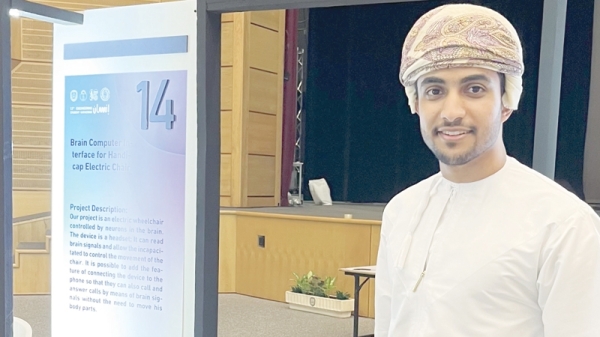By Buthaina al Riyami
While technology has grown immensely over the last decade, for people with disabilities, particularly those who are wheelchair-bound, there are still a lot of challenges that remain unaddressed.
While some wheelchairs can be operated by hand giving some PWD a little bit of independence when it comes to mobility, individuals like those with hemiplegia, paralysis, or loss of limbs still have to rely on someone to move their wheelchairs around.
Al Waddah al Battashi, an engineering student at Sultan Qaboos University, said that his smart wheelchair invention addresses this issue and that while some may consider this a minor discovery, he said this fills up a gap in the market for PWDs.
“This new wheelchair can be used by a wider group and address the needs of people with mobility disabilities. It can be used by individuals with hemiplegia, paralysis, or loss of limbs,” Al Battashi explained.
He added, “These people cannot use electric wheelchairs that are normally controlled by hand. I’ve devised this wheelchair to use EEG technology and was built upon the success of a colleague’s invention three years ago when he created an electric wheelchair that is controlled by eye movements,” he shared.
Al Battashi specialises in Mechatronics engineering. His invention was inspired not just by modern developments in the area of electro-encephalography technology (EEG technology) but by his peers with who said he has interacted at the university.
“I am studying at Sultan Qaboos University where I have a chance to interact with my peers who are with special needs. It opened my eyes to have a better understanding of their needs,” he said.
Al Battashi said it is a basic instinct for any human to grow independent whether in their character or movements. His interaction with his peers has inspired him and made him understand that even they too wanted to have more independence in what they can do and where they can go.
His research will eventually lead to the creation of a wheelchair controlled by the mind, using a computer-brain interface, and electroencephalography technology.
lectroencephalography or EEG is an electrophysiological procedure used to record electrical activity by using electrodes applied to the scalp. Electrodes measure voltage changes that are caused by the Ionic current in the brain’s neurons. Electrodes’ sensors detect brain waves and record them; then, amplify them and send them digitally to a device or a cloud database.
Al Battashi said the wheelchair will address an important gap in the market. He explained that the wheelchair contains a wireless headset whose sensors detect and record brainwaves and then send them as electro-encephalography to the wheelchair’s database. Finally, the brainwaves are translated into commands and transmitted to the wheelchair to respond according to the received commands.
Al Batashi’s aspirations for his project are to be tested and experimented with larger groups to verify the effectiveness of EEG technology in his project. Also, he looks forward to developing the headset to make it easier for daily use. He also hopes to be able to turn the headset into a cap, turban, or hijab. Hence, it became part of casual clothing and adapted to the Arabic culture.
He also looks forward to developing a headset with an open-source system to simplify the process of developing the wheelchairs and is even looking forward to applying the same technology to control prosthetics.
Finally, he suggested using this technology in a plethora of applications and fields. He clarified that there are many cases of uses for this technology, and by applying this technology, people will make huge leaps in the field of scientific invention. This technique can be applied to neuromarketing research for more accurate results. Also, it can be used in smart city applications and driving cars with minds. Many other uses and applications are waiting for great minds to show them to the real world.




